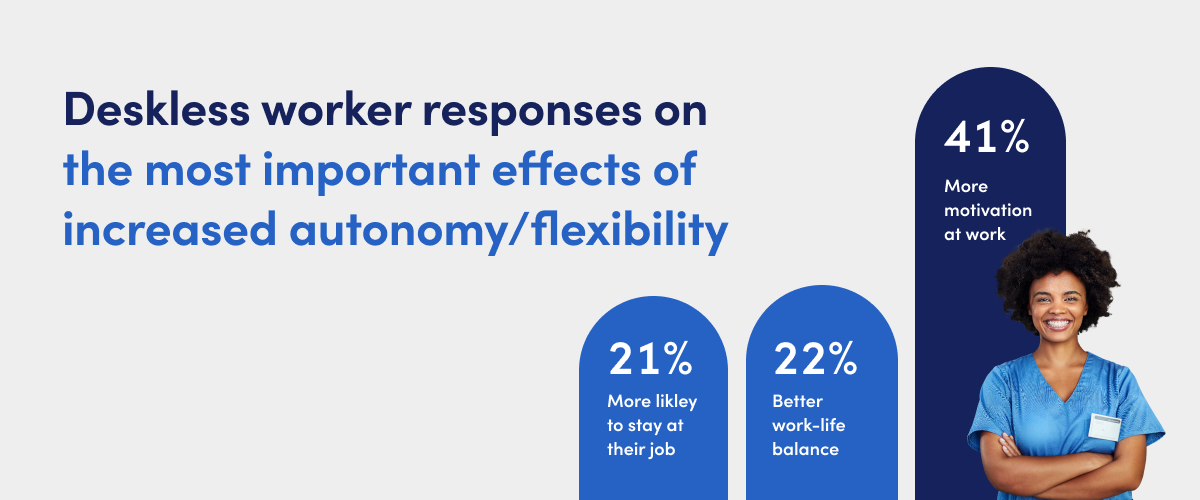Announcing 2022 State of Deskless Work Report
Where did you work from today? What about yesterday? Last month? Like many employees in the U.S., your answer probably changes week to week.
The past two years of distributed work and accelerated digital transformation have changed work for the better. Namely, today’s knowledge workers benefit from unprecedented levels of autonomy and flexibility. But at the same time, workers who sit at a desk in a traditional office setting are increasingly rare and currently account for just 1 in every 5 employees around the world. The other 80% of the global workforce is deskless, traveling and operating in the field. Sound familiar?
This workplace evolution impacts all of us, but much of the discussion has been focused on desk-based knowledge workers. So, we wanted to know: Have deskless employees experienced the same gains as desk-based workers or are divisions growing? And what does this mean for employers?
To answer these critical workplace questions, Skedulo surveyed 500 deskless employees based in the United States, as well as 500 desk-based employees for comparison. We asked employees about their job experiences, expectations and thoughts about the current workplace evolution to discover how changes in autonomy, flexibility and technology impact deskless workers’ satisfaction, productivity and retention.
Are you clocking in from a desk or somewhere else? Read on to learn what the findings of our 2022 State of Deskless Work Report could mean for you and your company.
While gains have been made over the past year, today’s deskless workers are still largely deprived of autonomy, ill equipped to handle increasingly dynamic and complex work environments, and face leadership that continuously prioritizes alternative investment areas.
Standout findings from our research include:
1. Your deskless workers are looking for opportunities that provide greater autonomy and flexibility: Over half (51%) of deskless workers would leave their current jobs to gain access to more autonomy and flexibility.
The pandemic gave employees a new level of control over how and when they work. But the deskless workforce—which includes home healthcare nurses, solar panel technicians, traffic control professionals and more—has historically lacked flexibility and autonomy over workflows, working hours and location. Look for ways to empower your workers with greater autonomy.
2. Flexibility is just as important as pay: Nearly half (47%) of deskless respondents would rather work for an organization providing flexible scheduling and/or increased autonomy over one able to pay them 10% more.
There are benefits for organizations that enable their workers to be autonomous and flexible. When we asked deskless respondents about the most important effects of increased autonomy/flexibility, they cited more motivation at work (41%), a better work-life balance (22%) and being more likely to stay in their job longer (21%).
As companies across industries face serious employee engagement and retention hurdles, listening to workers and accommodating their preferences is a win-win—resulting in more motivated, happier teams and fewer open roles.
3. Lack of purpose-built technology is a major obstacle for your workers: Cited as a major challenge, a quarter (25%) of deskless workers are hampered by insufficient technology and limited flexibility.
We’re not surprised to see insufficient technology as a top-three challenge. The deskless workforce has long been underserved when it comes to technology that is purpose-built for their specific roles and responsibilities, with the vast majority of software funding going toward products for desk-based knowledge workers.
The good news is that organizations are working to bridge this gap. Technology adoption is increasing for the deskless workforce, albeit slowly. Seventeen percent of deskless respondents said their organization uses 100% digital processes—up from 6% in our 2021 State of Deskless Work Research report. However, despite nominal gains, 83% of respondents are still using paper processes in some capacity.
4. Better technology equals greater worker retention: Deskless employees empowered with sufficient technology are 2x as likely to be very satisfied with their job and over 50% more likely to stay at their job for the next five years.
While deskless workers seem to largely enjoy their roles, they also aren’t feeling tied down to a specific employer. And this makes sense. The U.S. workforce just experienced a year of record-breaking turnover in an employee-driven labor market. As a result, deskless workers are realizing their value as irreplaceable frontline employees providing essential services. They’re more empowered than ever to seek out employers that match their work preferences—like increased autonomy. Rather than suffering through an unpleasant work experience, change is the more attractive option.
Don’t let employees find what they’re looking for elsewhere. Employers should pay close attention to the results of our study and survey their own workforce to identify opportunities to improve the employee experience for deskless workers.
For access to the full report and key findings download your 2022 State of Deskless Work Report.



